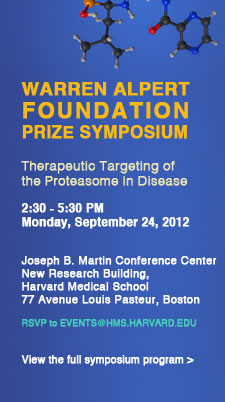 Four scientists instrumental in developing the drug bortezomib, which has radically altered the therapeutic landscape for hundreds of thousands of individuals with multiple myeloma, a deadly blood cancer, will be honored with the 2012 Warren Alpert Foundation Prize at a symposium at Harvard Medical School on Sept. 24.
Four scientists instrumental in developing the drug bortezomib, which has radically altered the therapeutic landscape for hundreds of thousands of individuals with multiple myeloma, a deadly blood cancer, will be honored with the 2012 Warren Alpert Foundation Prize at a symposium at Harvard Medical School on Sept. 24.
This year’s recipients are Julian Adams, of Infinity Pharmaceuticals, Alfred Goldberg, of Harvard Medical School, and Kenneth Anderson and Paul Richardson, both of Dana-Farber Cancer Institute.
The researchers will share an unrestricted prize of $250,000 and will be the featured speakers at the symposium, where they will discuss therapeutic targeting of the proteasome in disease. The symposium will be held from 2:30 to 5:30 p.m. in the Joseph B. Martin Conference Center in the New Research Building at 77 Avenue Louis Pasteur.
Goldberg will speak on the “Functions of the Proteasome: From Protein Degradation to Drug Development,” while Adams will discuss the discovery and development of Bortezomib. Anderson’s talk will center on “Bench to Bedside Translation of Proteasome Inhibitor Therapy in Multiple Myeloma,” and Richardson will provide insight into the “Clinical Development of Bortezomib in Multiple Myeloma; from Single Agent to Combinations and Beyond.”
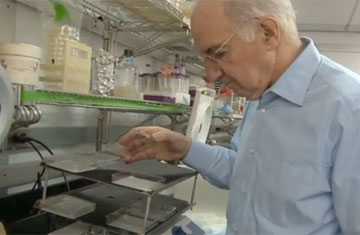
Found in Translation: The tale of the cancer drug bortezomib (Velcade)
The Alpert Prize, now in its 25th year, recognizes researchers for laboratory discoveries with dramatic promise to improve human health. The 40-year story of bortezomib, eventually marketed as Velcade, embodies the Alpert Foundation’s vision for honoring truly transformative science.
The late Warren Alpert, a philanthropist dedicated to advancing biomedical research, established the Prize in 1987. To date, the foundation has awarded more than $3 million to 42 individuals. Seven honorees have also received a Nobel Prize.
“The Alpert Prize was created to reward scientists whose queries into basic biological processes have resulted in new approaches to alleviating suffering caused by disease,” said Jeffrey S. Flier, dean of the faculty of medicine at Harvard Medical School.
“Adams, Anderson, Goldberg and Richardson’s discovery and development of bortezomib as a treatment for multiple myeloma beautifully matches and fulfills the mission of the prize of rewarding bench-to-bedsidetranslational research,” Flier said.
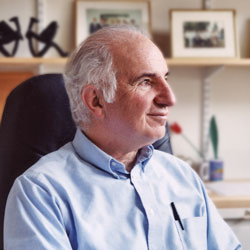 Bortezomib’s history began in 1966, when Goldberg, then a medical student, took a break from his studies in order to investigate a basic physiological question: Why do muscles shrink when they are not being used? He found that this loss of muscle mass was due to excessive protein breakdown in cells, a process that was very much a mystery and largely ignored at the time. Over decades, he and his co-workers demonstrated the existence of a new cellular waste-management system that disposes selectively of damaged or unwanted proteins in a cellular structure Goldberg named the proteasome.
Bortezomib’s history began in 1966, when Goldberg, then a medical student, took a break from his studies in order to investigate a basic physiological question: Why do muscles shrink when they are not being used? He found that this loss of muscle mass was due to excessive protein breakdown in cells, a process that was very much a mystery and largely ignored at the time. Over decades, he and his co-workers demonstrated the existence of a new cellular waste-management system that disposes selectively of damaged or unwanted proteins in a cellular structure Goldberg named the proteasome.
In 1993, he teamed up with three Harvard faculty and investigators to establish a company with the primary goal of inhibiting the proteasome in order to treat muscle-wasting conditions. Based on knowledge of the proteasome’s biochemical properties, inhibitors were synthesized that could block its function. Many of these initial compounds, forerunners of bortezomib, have since been used by thousands of investigators to uncover the proteasome’s critical roles in regulating many key processes.
The company then recruited medicinal chemist Julian Adams who led the development of drug-like compounds that could blunt the activity of the proteasome in whole animals. Through collaborations with researchers from the National Cancer Institute, these molecules were found to inhibit growth of tumors as well.
 The company eventually became a part of Millennium Pharmaceuticals, which continued to test Adams’ most effective inhibitor, now called bortezomib, on many different types of cancer. An important clue to the possible role of bortezomib in multiple myeloma emerged when its effect on a key growth factor called interleukin 6 was identified by Anderson and his laboratory team at Dana-Farber. Their critical preclinical studies of bortezomib and its effects on myeloma in its bone marrow microenvironment followed, showing remarkableanti-tumor activity, even when tumor models resisted all available therapies.
The company eventually became a part of Millennium Pharmaceuticals, which continued to test Adams’ most effective inhibitor, now called bortezomib, on many different types of cancer. An important clue to the possible role of bortezomib in multiple myeloma emerged when its effect on a key growth factor called interleukin 6 was identified by Anderson and his laboratory team at Dana-Farber. Their critical preclinical studies of bortezomib and its effects on myeloma in its bone marrow microenvironment followed, showing remarkableanti-tumor activity, even when tumor models resisted all available therapies.
When, at the same time, a patient with advanced multiple myeloma went into complete remission as part of an early Phase 1 study, the excitement around bortezomib grew. Richardson, also from Dana-Farber and, like Anderson, an expert in the disease, was enlisted to lead a series of clinical trials testing bortezomib in myeloma, verifying its activity and evaluating its promise in various disease settings, a process which took place at record-breaking speed.
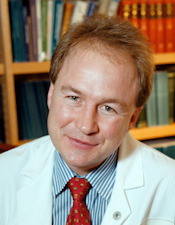 On a cellular level, the connection between multiple myeloma and the proteasome was at first obscure. Myeloma cells are cancerous forms of the white cells that normally protect our body by producing antibodies. Myeloma cells, however, create an abundance of abnormal antibody-like proteins. The proteasome normally destroys such abnormal proteins, thereby helping the disease progress. Inhibiting the proteasome would then deny these cancer cells the benefit of hijacking a normal and essential cellular process and also compromise the cancer’s other escape mechanisms.
On a cellular level, the connection between multiple myeloma and the proteasome was at first obscure. Myeloma cells are cancerous forms of the white cells that normally protect our body by producing antibodies. Myeloma cells, however, create an abundance of abnormal antibody-like proteins. The proteasome normally destroys such abnormal proteins, thereby helping the disease progress. Inhibiting the proteasome would then deny these cancer cells the benefit of hijacking a normal and essential cellular process and also compromise the cancer’s other escape mechanisms.
The first clinical trial showed that it did just that. At the trial’s conclusion, approximately one-third of patients responded well to bortezomib, one-thirdstabilized and one-third unfortunately progressed despite the treatment, although given that these patients were heavily pretreated and had exhausted all other available therapies, this outcome was seen as remarkable.
“For patients with no viable options left to treat their resistant disease, this was a profoundly meaningful result and extraordinarily hopeful,” said Richardson. “Side effects proved manageable and clinical benefit was quickly apparent. The study team built to rapidly develop the drug was simply second to none, and it was truly a privilege to have been part of it.”
“It was amazing to see how the initial anecdote of one patient turned into a multitude of patients,” said Adams.
In 2003, bortezomib was approved by the Food and Drug Administration. Since then, more than 300,000 patients worldwide have been treated with the drug, significantly extending life span for many. Based upon its success, four other proteasomeinhibitors are now in clinical trials, and other drugs affecting this cellular system are being developed.
“Just over a decade ago, there was relatively little we could do for multiple myeloma; patients would frequently die within months, and in fact only lived on average two to three years with the disease,” said Anderson. “Because of this drug, and especially now with combination approaches, I can say to a patient that you’re going to live at least five to seven years, and its likely to be even longer with the ongoing development of the next generation of novel therapies.”
“Bortezomib is a wonderful example of how basic biological information gleaned from thelaboratory bench can have such unforseen applications many years later,” said Goldberg. “I speak for all four of us when I say how wonderful it is to be recognized by the Alpert Foundation.”
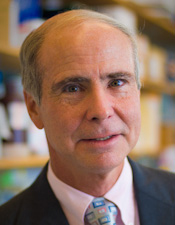 “This year represents our celebration of true scientific collaboration,” said Bevin Kaplan, director of the Warren Alpert Foundation. “All four winners are puzzle pieces to an inspirational and remarkable story.”
“This year represents our celebration of true scientific collaboration,” said Bevin Kaplan, director of the Warren Alpert Foundation. “All four winners are puzzle pieces to an inspirational and remarkable story.”
The Warren Alpert Prize has also recognized recipients for discoveries with direct impacts on a wide spectrum of diseases, including asthma, breast cancer, H. pylori, hepatitis B, and HIV/AIDS. Recent honorees include Alain Carpentier of Hôpital Européen Georges Pompidou in Paris and Robert S. Langer of MIT (2011) for innovations in bioengineering; Howard Green of HMS (2010) for revolutionizing skin restoration after severe burns; Lloyd M. Aiello of the Joslin Diabetes Center (2008/2009) for averting diabetes-related blindness; and Harald zur Hausen and Lutz Gissmann of the German Cancer Research Center (2007) for linking specific types of human papillomavirus (HPV) to cancer of the cervix.
The Warren Alpert Foundation
Each year the Warren Alpert Foundation (www.warrenalpert.org) receives 30 to 50 nominations for the Alpert Prize from scientific leaders worldwide. Prize recipients are selected by the foundation’s scientific advisory board, composed of distinguished biomedical scientists and chaired by the dean of Harvard Medical School.
Warren Alpert (1921-2007), a native of Chelsea, Mass., established the Warren Alpert Foundation Prize in 1987 after reading about the development of a vaccine for hepatitis B. Alpert decided on the spot that he would like to reward such breakthroughs, so he picked up the phone and told the vaccine’s creator, Kenneth Murray of the University of Edinburgh, that he had won a prize. Alpert then set about creating the foundation.
To award subsequent prizes, Alpert asked Daniel Tosteson (1925-2009), then dean of Harvard Medical School, to convene a panel of experts to identify scientists from around the world whose research has had a direct impact on the treatment of disease.
The Warren Alpert Foundation does not solicit funds. It is a private, philanthropic organization funded solely by The Warren Alpert Estate.


